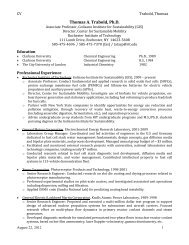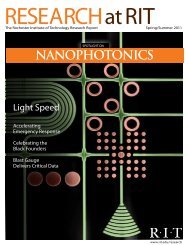Active Optical Isolator Using Adiabatic Wavelength - Rochester ...
Active Optical Isolator Using Adiabatic Wavelength - Rochester ...
Active Optical Isolator Using Adiabatic Wavelength - Rochester ...
Create successful ePaper yourself
Turn your PDF publications into a flip-book with our unique Google optimized e-Paper software.
1. Introduction<br />
<strong>Active</strong> <strong>Optical</strong> <strong>Isolator</strong> <strong>Using</strong> <strong>Adiabatic</strong> <strong>Wavelength</strong><br />
Conversion in Microcavities<br />
Ali W. Elshaari* and Stefan F. Preble<br />
Microsystems Engineering, Kate Gleason College of Engineering,<br />
<strong>Rochester</strong> Institute of Technology, <strong>Rochester</strong>, New York 14623, USA<br />
*Corresponding author: awe2048@rit.edu<br />
Abstract: We present an integrated optical isolator based on adiabatic wavelength conversion in<br />
microcavities. The isolator uses a time-division sampling method to ensure complete isolation of<br />
optical pulses with an extinction of 24 dB.<br />
©2009 <strong>Optical</strong> Society of America<br />
OCIS codes: (130.3120) Integrated optics devices; (230.3240) <strong>Isolator</strong>s.<br />
<strong>Optical</strong> isolators are a critical need for CMOS compatible silicon nanophotonic chips. Recently a new technique for<br />
achieving optical isolation, one that doesn’t require the use of magnetic materials, was proposed where a nonreciprocal<br />
system is used to discriminate between backward and forward propagating modes [1]. This is achieved by<br />
preferentially inducing an intramode transition only to the backward propagating light of a multimode waveguide<br />
[1]. However, there will be considerable challenges in realizing this in practice since it inherently requires a phase<br />
matching and mode conversion process that is implemented with high speed (10’s of GHz) and wavelength-order<br />
periodic refractive-index modulations of portions of a waveguide. In addition, due to the limited refractive index<br />
change from free-carrier plasma dispersion that is possible in silicon the required length of the device is on the<br />
order of millimeters. While it is possible to reduce the size of the device using a ring resonator it will still be<br />
inherently challenging to achieve the required modulations and mode matching. In contrast here we present an<br />
isolator based on adiabatic wavelength conversion, which was was recently demonstrated in silicon microcavities<br />
[2,3]. There are no requirements on what resonant mode is used, or how the modes are spaced. In addition, the entire<br />
resonator can be tuned to achieve isolation, as opposed to precisely engineered portions, greatly reducing the device<br />
design constraints.<br />
2. <strong>Isolator</strong> design and operation<br />
A schematic of the proposed isolator is shown in Fig 1. The device works by inputting a “red” frequency signal<br />
traveling from left-to-right into a wavelength converter, which converts the input signal to a “blue” frequency and<br />
then lets it travel to the rest of the photonic circuit. If any of the “blue” light is reflected it will be caught by a “blue”<br />
filter which will effectively keep it from traveling back to the input of the photonic circuit, in turn, realizing optical<br />
isolation. <strong>Wavelength</strong> conversion is achieved by using a micro-resonator, which traps the light for a brief time in a<br />
“red” resonant mode. While the light is trapped the refractive index of the entire resonator is adiabatically tuned,<br />
which shifts the lights wavelength to a new “blue” frequency via the adiabatic wavelength conversion effect [2, 3].<br />
Fig.1 Red inputs pass by the blue filter and get coupled to the wavelength conversion unit which converts the “red” input to “blue” light. If there<br />
are any reflections the blue light is effectively isolated by the blue filter.<br />
The degree of optical isolation is inherently determined by the conversion efficiency from the “red” to “blue”<br />
frequency. While the adiabatic process theoretically has a 100% conversion efficiency [3] this is only achieved if all<br />
of the light in the pulse is completely trapped in the resonator. However a wavelength conversion system with a<br />
single resonator fundamentally can not achieve 100% conversion efficiency [2] because of the discrete nature of the<br />
tuning process and the time-bandwidth limit of the cavity. Since all of the light fundamentally cannot be converted<br />
in one resonator here we propose to use multiple resonators to sample portions of the pulse with time, which we call<br />
time domain sampling (TDS). TDS is achieved by cascading several identical optical cavities in series, all with a<br />
bandwidth larger then the input pulses bandwidth in order to ensure that all the frequency content is captured. Note
that the cavities inherently are not coupled to each other. By using TDS we can ensure that the entire pulse is<br />
trapped for the adiabatic wavelength conversion process.<br />
We used Finite Difference Time Domain simulations to model the isolator as shown in Fig. 2 where a snapshot<br />
of the simulation is shown. The TDS wavelength conversion unit consists of seven ring resonators shown in the<br />
middle. They all have a radius of 2µm and are centered at a resonant wavelength of λ 1 =1554.9nm. There is a blue<br />
ring filter at the input which has a slightly different radius in order to have a resonant wavelength of λ 2 =1552.7nm.<br />
The isolator works as follows: (1) An input signal (Gaussian pulse of 3ps duration) centered at λ 1 is launched into<br />
the system. It passes past the blue filter and then enters the system of cascaded TDS rings. Since the pulses<br />
bandwidth is smaller than that of the rings the entire content of the pulse will couple to each of the rings as seen in<br />
the simulation in Fig. 2. (2) When all of the rings are fully excited their refractive index is reduced by δn/n=1.4E-03,<br />
which will reduce the wavelength of all of the light from λ 1 to λ 2 via the adiabatic wavelength conversion effect<br />
[2,3]. This is seen in the input and output spectrums plotted in Fig.2 where we achieve 100% conversion efficiency.<br />
While here an index change of 1.4E-3 was required this is only because of the very short pulse used and the<br />
inherently low Q of the small radius resonators that were used in order to minimize computation time. In practice an<br />
index change on the order of 1E-4 would be adequate for tens of picosecond pulses.<br />
Fig.2 Finite-Difference Time Domain Simulation of the <strong>Isolator</strong>. A “Red” to “Blue” conversion unit consisting of seven ring resonators converts<br />
“red” light at the input to “blue” light at the output. A blue filter at the input isolates the reflected pulses. The red curve shows the spectrum of<br />
the input pulse. The blue curve shows 100% conversion of the red input pulse to a new “blue” wavelength at the output.<br />
To demonstrate isolation we introduced a highly reflective broadband distributed Bragg reflector (DBR) mirror<br />
at the output of the isolator in order to redirect the converted waves back to the input port (reflection of ~99%). As<br />
seen in Fig.3 all the reflected signal is isolated from the input and redirected to the drop port of the blue ring filter, in<br />
turn, achieving an isolation of 24dB. This isolation can be further increased by adding higher order blue filters to the<br />
system.<br />
Fig.3 When a reflected signal is sent back to the input (in this simulation by a DBR mirror) it is completely redirected to the drop port of the blue<br />
filter . The plot shows the spectrum of the forward and backward waves where we measure an extinction ratio of 24dB.<br />
In conclusion, here we presented a design for an integrated optical isolator employing adiabatic wavelength<br />
conversion in microcavities. It achieves complete isolation with an extinction ratio of 24dB using simple refractive<br />
index tuning of several cascaded resonators. The active nature of this isolation process inherently is suited to work<br />
with pulsed data used in high speed optical communication and optical signal processing systems. Note that while<br />
we will need to tune the resonator on the order of the photon lifetime this is becoming possible with the latest<br />
electro-optic modulators [4]. Lastly, in order to avoid back-conversion of reflected light (from blue to red) the<br />
resonators would need to be tuned back on the order or slower than the photon lifetime of the individual resonators,<br />
which imposes an upper limit on the bit-rate the system can operate at (~10-20 Gbit/s).<br />
3. References<br />
[1] Z. Yu and S. Fan. “Complete optical isolation created by indirect interband photonic transitions” Nature Photonics 3, 91 - 94 (2008)<br />
[2] S. F. Preble1, Q. Xu, and M. Lipson. “Changing the colour of light in a silicon resonator nature photonics” Nature Photonics 1, 293 - 296<br />
(2007)<br />
[3] M. Notomi, and S. Mitsugi. “<strong>Wavelength</strong> conversion via dynamic refractive index tuning of a cavity” Phys. Rev. A 73, 051803 (2006)<br />
[4] A. Liu, et al. “Recent development in a high-speed silicon optical modulator based on reverse-biased pn diode in a silicon waveguide”,<br />
Semicond. Sci. Technol. 23 064001 (2008)

















